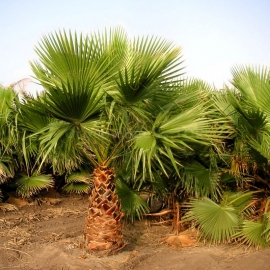




«Fan» - Organic Washingtonia Seeds
3.00 €
Native to the southwestern U.S and Baja California, the California fan palm is 1 of the 11 native palms in North America. It has a large, gray unbranched trunk, with horizontal lines. The trunk is 2-3 feet in diameter, and grows 20 to 60 feet long.
-
Organic Washingtonia «Fan»
Native to the southwestern U.S and Baja California, the California fan palm is 1 of the 11 native palms in North America. It has a large, gray unbranched trunk, with horizontal lines.
The trunk is 2-3 feet in diameter, and grows 20 to 60 feet long, with hooked spines along the edges. It grows naturally near desert oases, or moist soils near alkaline streams, and mountain canyons. The fan shaped leaves spread from around the top while many old leaves hang on the trunk. This provides a protective habitat for many animals, including birds, insects, and small rodents.
How to Grow
Left in a natural state, browned fronds of a washingtonia palm will form a very long "hula skirt" of thatch. Most people, however, prefer a cleaner look and trim off old fronds fairly often. Once the palm is too tall to reach, leave the old fronds on or hire someone to trim.
"Boots" (old leaf bases) are a bright and attractive red-brown while the palm is young. As they age, you can remove them by hand or leave them on (they'll fall off on their own eventually) to form a spiky decoration above the smooth trunk. Washingtonias are happier in a less humid climate than ours, so pick a sunny, well-drained place where the palm will get good breezes. Soil amendments aren't really necessary.
Watering on a regular basis with time to dry out between waterings will keep the palm looking its best. Fertilize in spring, summer and fall with a good palm fertilizer containing micronutrients. Beware of the sharp teeth on the palm's leaf stems.
